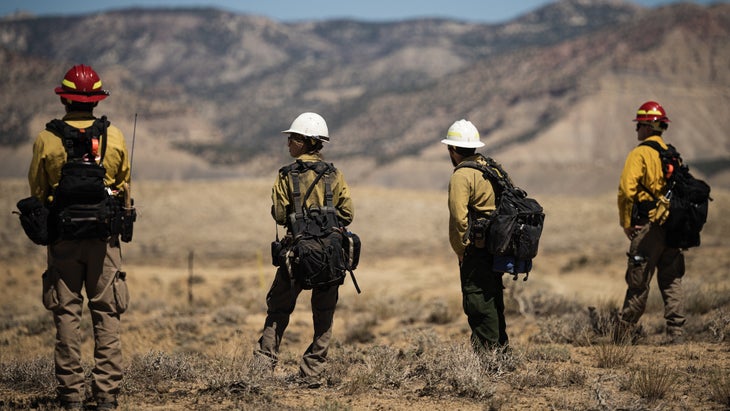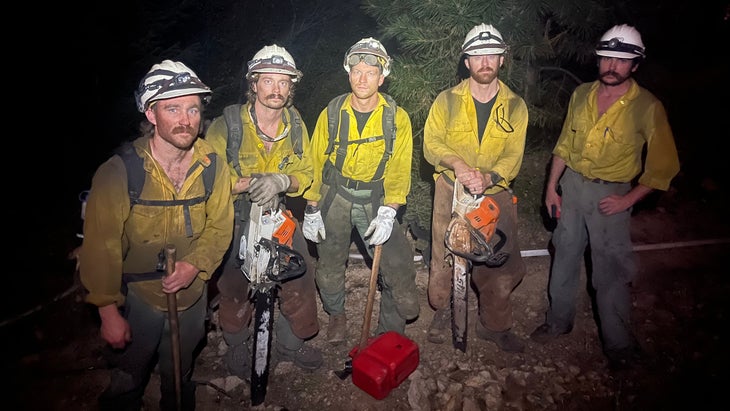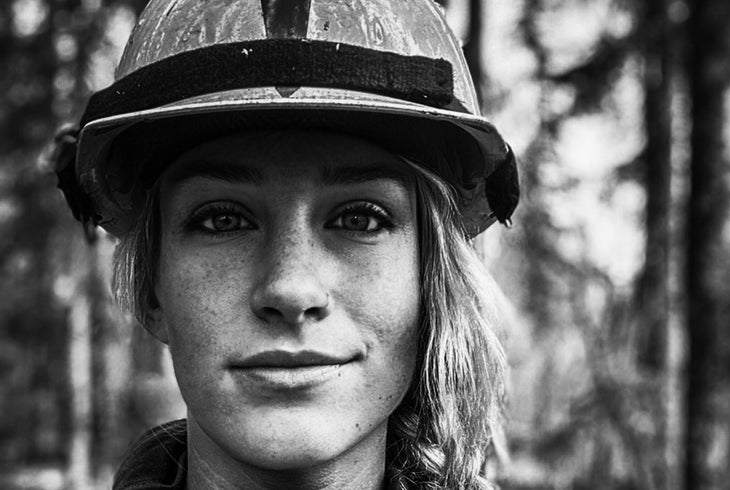No products in the cart.
Outdoor Adventure
Hotshot Firefighters Are Coming for Ultramarathons
It’s day nine. I haven’t showered in over a week. In these last nine days I’ve worked 144 hours, my skin is blistered by the wind and sun, my feet look like hammered dog shit, and my lunch’s sandwich meat looks to be made of an otherworldly material. Five more shifts to go. Fourteen days of 16-hour stints, hiking up ridge tops, ascending down into drainages, then up and down again with 40-plus pounds strapped to my back.
Welcome to the world of hotshots.
What Is a Hotshot?

Interagency Hotshot Crews (IHC), known as “hotshots,” are akin to the A-teams of fire suppression. Our elite squads consist of 20 to 25 personnel assigned to the most dangerous, tactical, and challenging wildfires in the country. I’m sure you’re not surprised that we’re required to maintain a high level of physical fitness, but it’s not uncommon that many hotshots are also ultrarunning fanatics.
As the fire season comes to an end, firefighters begin focusing on their health and fitness. Although strength training is an important aspect of our routine, running is our bread and butter come winter. Putting in the miles throughout the off-season, especially on trails, is proving to be the best way to maintain and improve our cardio and endurance.
LISTEN: The Real Lives of Wildland Firefighters
As an active crew member on an IHC in Montana, I’m seeing firsthand how hotshots throughout the country are gearing up for ultramarathons. Despite working more than 1,000 hours of overtime in only six months, once laid off for the winter, many firefighters like me are signing up and becoming contenders in ultra-distance races around the country.
This line of work often attracts a particular type of person, someone who is familiar with pushing their limits and being comfortable with discomfort for hours on end. Working long hours on rugged, wild land requires endurance, core strength, stability, and the ability to manage fatigue and mental acuity amid ever-changing environmental surroundings. Suffice to say, ultrarunning is the perfect sport for wildland firefighters.
I had the opportunity to speak to three hotshots who are pursuing ultras after the summers of wildland firefighting ended. What keeps them coming back to these challenges? Where do they find the strength to keep pushing after fire season? Don’t their feet hurt?
Nothing Feels Impossible After Fighting a Forest Fire—Not Even an Ultra

Sarah Fondaw, 30, from Helena, Montana, is a member of Lewis & Clark Hotshots, located in Great Falls, Montana. After her first season as a hotshot, she completed her first ultra, the Copper Corridor 50K, and has since signed up for the Black Canyon 60K in February.
“It’s fun to try to push yourself and toe that line of what I can do,” says Fondaw. “To be curious about what your body can do, what your mind can put you through, and most importantly, what your mind can get you through.”
She never thought she could get on a hotshot crew because the physical aspect was daunting. It was only after she secured her spot on the crew that Fondaw discovered she could achieve things she didn’t originally think possible. And that’s when she started training for her first ultra. What keeps her coming back to both the crew and ultras is the challenge and satisfaction that comes from conquering it.
“On the surface, it’s just good training for the upcoming season of course,” she says. “But I also think it makes the transition out of fire season back to real life easier because you feel like you still have a purpose. When you give yourself a training program and maybe sign up for a race, it can be really meditative and good for your mental health to have that consistency, spending time outside on your own terms after the season is over.”
Being Comfortable with the Uncomfortable

Josh Nelson, 31, from Tryon, North Carolina, was a member of Globe Hotshots, located in Globe, Arizona, and Cherokee Hotshots, in Unicoi, Tennessee. However, he recently left the crew life to pursue ultrarunning professionally.
Nelson, also a U.S. Army veteran, has competed in numerous races over the years, most recently under the sponsorship of Fleet Feet Asheville and the apparel company, Zensah. In fact, he ran a stunning 16 ultras last year alone. Nelson explains that after working on a hotshot crew, he found he had a significant mental edge over the general public during ultras.
“It’s easier to mentally get over the fact of running a race in the mountains when you’ve worked in fire,” he says. “It’s not such an extreme thing anymore, having the ability to just be uncomfortable. It’s things like that we take for granted.”
“Jumping into ultras is being able to push through hard things, which is the reason I think a lot of people get into fire, too. Both of these worlds are very similar in that way.”
For Nelson, mental health plays a large part in why he joined a hotshot crew and why he continues to run ultras.
“What am I doing to make my life better? How can I make other people’s lives better?” he says. “How can I at least feel like I’m somewhat of a role model for people? I think the fire and ultra world are both pretty easy to bridge that gap and can give you a sense of purpose. I’ve had depression in the past. I fought a war when I was 18. Jumping into ultras is being able to push through hard things, which is the reason I think a lot of people get into fire, too. Both of these worlds are very similar in that way.”
Painful but Worth It

Dani Goodson, 36, from Missoula, Montana, has spent many years as a hotshot and is currently a squad boss on Lolo Hotshots. She has run a number of 50Ks and is currently focusing her training efforts on the Running Up For Air series in Missoula, Montana. A lot of her motivation for training and competing throughout the winter is about keeping structure in her life and not becoming complacent, especially during a time where many people gravitate towards hibernating on the couch.
“You go from the hard work, structure, and camaraderie of the crew and having every minute of your life spelled out in the summer, to all of a sudden being unemployed come winter,” says Goodson. “I found that once I started running ultras I actually have this goal throughout the winter. It was just a way, especially when I lost the structure of being with the crew, to get some consistency back in my life, and keep it goal-oriented. It gives me a reason to get out the door and keep doing something physical in the off season.”
RELATED: The Incarcerated Women Risking Their Lives to Fight Wildfires
Goodson also found a sense of community in the ultra world. She explains that, although she felt like an outsider at first, everyone she met was very supportive and offered advice and moral support along the way.
“It was cool to go into it like a tourist and to realize, wow, these people are all super supportive and everybody is really having a good time,” she says. “That’s one of the things I also love about hotshotting. Things can really suck but everyone is still having a good time with it.”
It’s no secret: the planet is heating up year after year and climate change is at the forefront of discussions, both in Congress and at the local brewery. With the future at stake, many people are looking at ways to become more involved with the solution, whether that’s climate activism, fire ecology, or staring the beast right in the eyes and training to become wildland firefighters.
Distance running has increasingly become the shoe that fits for those who decide to swing tools and arm themselves with chainsaws to combat increasing wildfires. As each fire season becomes hotter and drier, you may also see an uptick in hotshots at your next race. Be sure and give them a fist-bump and thank them, because being a hotshot is often a selfless and, at times, underappreciated gig.
Source link

